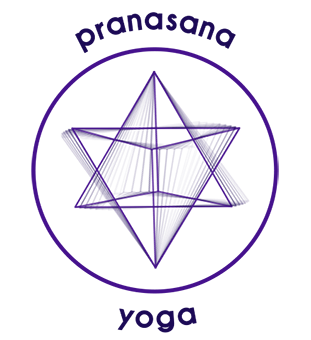
Yoga teaches that our being consists of 5 layers or koshas that surround the atma – our true-self/God self. These are from gross to subtlest: The physical body (annamaya kosha), the breath body (pranamaya kosha), the mental /emotional body (manomaya kosha), the wisdom body (vijnanamaya kosha) and the bliss body (anandamaya kosha). Separating them as different entities makes it easier for the left brain to grasp the concept but, these layers are not truly separate. They are all different aspects of the same manifestation – our being. There is nothing that happens in any of these layers that doesn’t affect the rest and all of these receive and project the light of Atma or God out of which they evolve.
In yoga, we shine the light of awareness on all these koshas. Through asanas (or postures) we see the physical body clearly. As we become conscious of our breathing, we get to know how much this subtler body can expand. We watch what we think and how it makes us feel as we get to know the hold of our mind and emotions on our being. We practice meditation and concentration which quieten the mind allowing the inner wisdom to come forth. As we ease in our skin, we feel the presence of the inner guru which opens and activates our bliss body. The mind opens and receives true knowledge from the wisdom body which affects all other layers. It is impossible to pay attention to one kosha and not affect the rest. When our physical body feels tight and closed, it affects the way we breathe. Our mind starts the hunt for reasons that would explain this inner discomfort which manifests as a sensation in our body we call emotion. If we remain unconscious to what is happening, we close the wisdom and bliss body off. This doesn’t imply that if we have a tight body, we’ll never have bliss as there are many doorways ‘koshas ‘ to the source. One can enquire into the mind or work with the breath and the benefits will be passed onto the physical body which will affect the rest and so the dance continues. My personal experience shows me that it serves to pay attention to all these koshas individually and to get to know the subtler bodies as well as the gross physical body.
Each of these koshas has been affected by the life we’ve lived. I believe that they each, although have the capacity to expand, have at any given time a limit, in order to maintain balance within our entire system. For example, we can’t take the breath beyond its limit and push against it constantly without creating imbalance in the physical body or other koshas. Also, it is impossible to open and expand one of the koshas beyond the limits of the others. For example, you can’t open the physical body beyond the breath. Pushing and pulling parts of the body without the ability to consciously move the breath where the body expands won’t bear gratifying benefits. It’s easier to notice this interaction on the grosser level but the same dance exists on all levels. It is clear that if we deny the limitations or stop paying attention to any of these layers, we’re affecting the entire system as a whole.
In the spiritual community, there is a tendency to deny the limitations of the manomaya kosha (the mind/emotional body). This is usually done in the name of detachment. I have seen many, when faced with an emotional challenge, saying ‘I am not my emotion, nor my body’ while being clearly in an emotional state and totally identified with the bodies. This is a knowledge that may have been experienced in meditations where the wisdom body reflected this truth to the mind – opening it to truth. However in this case, the person has lost touch with this truth and is only referring to this as a memory. The mind is clearly closed off from the wisdom body as the words are not coming directly from that space. In such cases, the answer is to stop pushing against the mind’s limitations and recognise that it has closed and is in a tension phase. Instead of pretending it’s as open as it was when we mediated, we practice what has the potential of opening it again while totally respecting its limitations. This could be as simple an act of gardening to retune the mind body to the wisdom and bliss body.
In the same way that we don’t push the body into an uncomfortable pain and stay with comfortable discomfort to open the body, we learn to do the same with the mind/emotion body. So what does it mean not to try and open the mind/emotion body beyond its current limitations? It means that when faced with a situation that is challenging our belief system and triggering our emotions, there will be discomfort. This discomfort might be comfortable enough for us to stay with the situation and work with it by enquiring, checking whether those beliefs are still true for us or practicing awareness. Otherwise, in case the discomfort is unbearable, we remove ourselves from the situation or communicate that we’ve hit an internal limitation. This is much easier to communicate outwardly when we don’t have any problems with having limitations. In the same way that our asana practice is filled with joy when we’re not constantly fighting our own boundaries, our relationships and dance with others will be much more enjoyable if we stop denying our limitations. After all is a relationship not a joint practice of 2 mental/emotional bodies?
Detachment is by no means a tool for denying what is going on and numbing our emotions. Is it possible that the detachment that is required is detachment from what we view as our limitations?
March 2012
